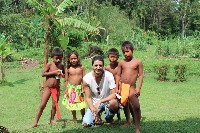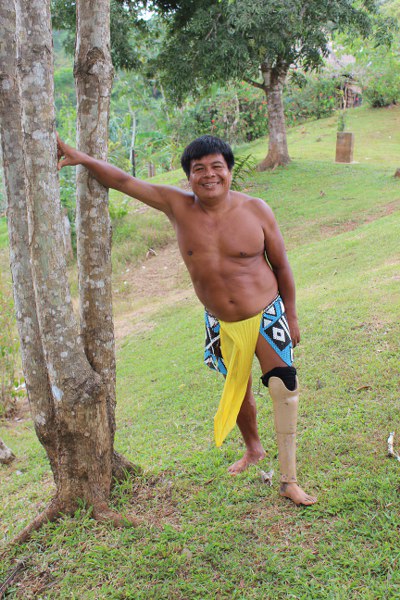A Brief Visit to Panama's Emberá Quera Tribe

I couldn't help but fall somewhat in love with Elizabeth, a 16-year old Emberá tribes-girl, as she painted a traditional tattoo on my shoulder using an ink made from a local juaga fruit. She worked slowly and meticulously, giving me plenty of time to study her, though she no doubt felt my North American glare upon her. But how could I ignore her crown of vibrant crimson flowers or her perfect chocolate complexion. Her lips were tinted red with the fruit of some tree I have surely never heard of. How could I look away from her top as it jangled with the bustle of hundreds of ordaining coins or her heavily patterned sarong wrapped tightly around her unshaved legs? She spoke softly when answering the trite questions I could muster up in my confused Spanish and, while doing so, she would sometimes look up at me, always with a flutter of her long eyelashes.
Although the dugout (a canoe made from a hollowed tree trunk) had a Yamaha outboard hanging off the back of it, we moved ever-so-slowly through the labyrinthine waterways on our way to the village island. A young Emberá tribesman steering the motor and a second stood almost guard-like at the bow with his long brown hair, bandoleers and a beaded skirt so short, and so tight, it left him practically naked. Not once did he move as we passed by fishermen casting their nets from dugouts so shallow they looked as if they were sitting in the river. Or when we passed a herd of black bulls grazing on the muddy banks not ten feet from us. Or even when we floated by a man in what looked like a hundred year old canoe painted yellow with the word TAXI scrawled up the side of it.
In this tranquil, exotic fashion we approached the village of Emberá Quera. Within a clearing of the dense green foliage I could make out a pocket of ten or fifteen cone-shaped bohio huts with thatched palm roofs, dotted at different distances up the hillside. A thin, low-lying mist that blended the scene together lent itself to the overall majesty of the landscape. And as we came upon the pier that jutted out at the foot of the village, the motor behind me ceased and the sounds of tribal drums and tribal flutes and tribal claps wafted toward me, though the misty air. On one side of the grassy knoll were lined the Emberá woman clapping and smiling and beautiful - one of which was Elizabeth - and opposite them on the knoll were their male counterparts who played instruments and danced.
It was my first time visiting The Emberá, a semi-nomadic aboriginal people who make up part of the 12.3 percentile of indigenous Panamanians. Though most of the Emberá are nestled deep in the Darién jungle, this particular tribe, The Emberá Quera, live on the shores of one of Rio Gatun's picturesque tributaries - they weren't always there however. Atilano, one of the tribesman and the village's tourism liaison, told me that almost seven years ago, a handful of Emberá families withdrew from their Darién settlement to escape the F.A.R.C and other violent Colombian Guerrilla movements in search of safer and more opportune land. And the fertile banks of Rio Gatun made an ideal haven for the tribe, now nineteen families strong.
Shortly after arriving and meeting some of the tribe, I was fed a freshly fried fillet of tilapia and some pataconés (fried green plantain) inside a banana leaf cone - a staple meal for the Emberá. And it was a welcome offering too, after a morning of tiring travel from Panama's southern interior, through the capital and over the mountains to the Atlantic coast.
After my modest lunch I was brought around the village by one of it's inhabitants, Emerijildo, a 54-year-old artisan and botanist who was fitted with a crude prosthetic leg from the thigh down - a feature which seemed to slow him down none. He took me to the village's single-room, open-air school which was surprisingly well outfitted with four large chalkboards (which also doubled as walls on two sides), fifteen or so wooden chair-desks for students and even a funny pink sign on the wooden post at the entrance that read 'Hasta Manaña' (Spanish for 'See You Tomorrow').
Emerijildo told me that Ricardo Martinelli, Panama's somewhat controversial President, offered to fund the construction of a modern, red brick school house for the Emberá Quera village a year ago. An offer which they had little interest in. The Emberá have no need for bricks and mortar and modern construction, Emerijildo said. They want to keep their traditions and ideals as intact as possible in this rapidly changing world. And I certainly don't blame them for it either. It takes not ten minutes before one realizes that this homespun village, steeped in all its antiquity and simplicity, has life figured out. Emerijildo, who lost his leg 18 years ago felling a large tree for a forty-nine-foot long dugout canoe, is all smiles and laughter while he describes the accident as we stand in front of the village's red clay football pitch.
Atilano, who was perhaps the most naked of all the men wearing just a burnt yellow cloth tucked between his buttocks and pulled forward over his genitals, told me that the worst crime that happens in the village is when two people get into an argument. And what is the punishment for such a misdemeanour? The accused must clear the encroaching jungle growth with a macheté. With a legal system fuelled by community discussion, the Emberá Quera seemed to have boiled down democracy to its lowest working denominator. The village, much like its male inhabitants, has no perceivable fat or excess. It runs like a machine with no unnecessary pumps or pistons. Not to mention the village functions without electricity or running water.
Traditionally however, the Emberá are used to having more land at their disposal. Atilano told me that in the Darién jungle they had more than twenty acres upon which they could grow rice and corn. But now, on Rio Gatun, they could only afford nine acres (which cost them $30,000), a piece of land so compact so they must rely more on things like fruit trees and fishing for sustenance and income. Though in the coming months, they hope to begin raising some animals on the land and build a few more bohio houses.
By two in the afternoon, the sun was beating down hard on my white skin and I was alone in breaking a sweat. Catching back up with Emerijildo beneath one of the village's larger bohios, I hinted not-so-subtly at how fond I was of his ornate arm tattoos which faded roughly into his dark brown skin. Not long after that, Elizabeth appeared with a small, plastic bottle filled with black ink and a thin, broken-off bamboo skewer. We sat side by side on a wooden bench in the shade. The sleeve of my white t-shirt rolled up on my shoulder as she worked painstakingly, line by line, painting a band around my arm for twenty minutes or more.
Then the villagers broke into fervent song and dance. Calloused feet shuffled in the red clay, kicking up dust. Hallow gourds were tapped and skin-drums were slapped and wooden flutes were blown. The men once again played the instruments, making a group in the middle under the hut as the woman danced around them in a circle smiling and swaying their hips as their coin shirts jingled. And Elizabeth held my hands delicately all the while as my big white feet stumbled over one another clumsily trying to follow her in dance.
I had the distinct feeling as though I had crash-landed on an alien planet in some far-flung galaxy. I've travelled my fair share, but never before had I visited a community that is so secluded and raw, so committed to a praxis of which is so foreign to me. Never before have I felt so profoundly different from a group of people, yet so deeply connected to them as well. It's safe to say that I did fall a little in love with Elizabeth that day. And the impressions left on me by her and the Emberá Quera will last long after the juaga tattoo on my shoulder fades away.











